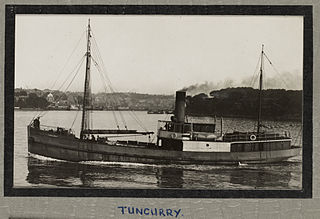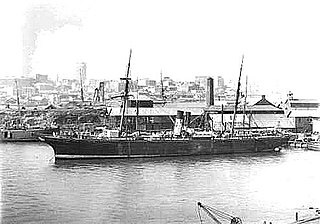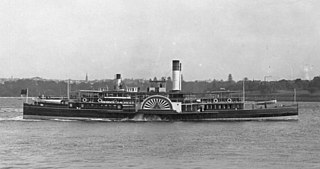
SS Yongala was a passenger steamship that was built in England in 1903 for the Adelaide Steamship Company. She sank in a cyclone off the coast of Queensland in 1911, with the loss of all 122 passengers and crew aboard.

The Pacific Mail Steamship Company was founded April 18, 1848, as a joint stock company under the laws of the State of New York by a group of New York City merchants. Incorporators included William H. Aspinwall, Edwin Bartlett, Henry Chauncey, Mr. Alsop, G.G. Howland and S.S. Howland.

The Kyarra was a 6,953-ton steel cargo and passenger luxury liner, built in Scotland in 1903 for the Australian United Steam Navigation Company.

The Illawarra Steam Navigation Company was a shipping company that serviced the south coast of New South Wales, Australia from 1858 to the early 1950s. It was formed through the amalgamation of the General Steam Navigation Company, the Kiama Steam Navigation Company and the Shoalhaven Steam Navigation Company, each of whom serviced parts of the south coast with their respective vessels. After merging, the new company held a near monopoly in regard to shipping on the south coast, and their fleet visited every significant port between Sydney and the border of Victoria. The company transported both passengers and a range of produce, including livestock, and hence it became known as the 'Pig and Whistle Line': it was said that ships would wait an hour for a pig but not a minute for a passenger.

The SS Cawarra was a paddle-steamer that sank on 12 July 1866 in Newcastle harbour, New South Wales, Australia sending sixty people to their deaths. The sinking was one of the worst maritime disasters in Australian history.

SS John Oxley is a steamship that previously was a pilot boat and lighthouse and buoy tender. The ship was built in Scotland in 1927 for the Queensland Government. The vessel was requisitioned by the Royal Australian Navy during World War II. Returned to her duties after the war, John Oxley remained active until 1968 when her deteriorating condition made her unusable. In 1970, the ship was donated by the Queensland Government to the Lady Hopetoun and Port Jackson Marine Steam Museum for preservation, but due to other projects, work was sidelined until 2004. The ship has undergone restoration for the past 20 years at Rozelle Bay on a floating dock. In April 2022, she was towed to dry dock at Garden Island, re-floated successfully and returned to Rozelle Bay for further restoration work afloat.

The Lucinda was a Queensland Government owned, 301-ton paddle steamer built by William Denny and Brothers, Dumbarton, Scotland in 1884.

RMS Quetta was an iron-hulled steamship that was built in Scotland in 1881 and wrecked with great loss of life in the Torres Strait in 1890. She was operated by British India Associated Steamers (BIAS), which was controlled by the British India Steam Navigation Company (BISN). She was wrecked on a previously unknown rock, which has been called Quetta Rock ever since. The Underwater Cultural Heritage Act 2018 protects the wreck.

SS Mareeba was an Australian cargo steamship that was built in 1921 for the Commonwealth Line as Echuca, named after the town of Echuca in the state of Victoria. In 1924 the Australasian United Steam Navigation Company bought her and renamed her after the town of Mareeba, Queensland.

The Tuncurry was a wooden carvel screw steamer built in 1903 at Cape Hawke in the Australian state of New South Wales, that was wrecked when she sprang a leak whilst carrying explosives, cement, whiskey, jam and other general cargo between Sydney and Brisbane. She was lost off Barrenjoey Head, Broken Bay, New South Wales on 22 October 1916.

City of Adelaide was an iron-hulled ship that was launched in Scotland in 1863, spent a long career in Australian passenger and cargo service, and sank off the coast of Queensland in 1916. She served with several Australian shipowners, including the Australasian Steam Navigation Company, Australasian United Steam Navigation Company and Howard Smith Company.
William Henry Paxton was a prominent businessman in the early days of Mackay, Queensland.

The Australasian United Steam Navigation Company (AUSNC) was an Australian shipping company formed in 1887 by the merger of the Australasian Steam Navigation Company and the Queensland Steam Shipping Company and their fleets. It existed from 1887 to 1961.
The Queensland Steam Shipping Company was a shipping company of Australia from 1881 to 1887.
'Sugar Lighters in the Johnstone River, Queensland' In the early days of settlement at Geraldton [now Innisfail], the Johnstone River had a sand bar at the mouth and several shallow stretches in the river. This caused difficulties for shipping. Large ships had to either anchor at the mouth of the river and wait for a suitable high tide so that the bar could be crossed or anchor in Mourilyan Harbour to the south. The problem of large ships being unable to enter the river made it difficult for bags of sugar from the district sugar mills to be transported to southern refineries. To overcome this problem, shallow draft steam ships and lighters [often called sugar lighters] were used to carry the bags of sugar down the Johnstone and out to meet larger ships standing off the coast. or in nearby ports, mainly Cairns. These larger ships then transported the cargo to its destination. These small ships became known as "The Mosquito Fleet".
Bishop Island was an island near the mouth of the Brisbane River in Moreton Bay, Queensland, Australia.
Ipswich Town Wharves are heritage-listed remnants of wharves beside the Bremer River at Bremer Street, North Ipswich, City of Ipswich, Queensland, Australia. They were built from 1847 to c. 1927. They were also known as Australasian Steam Navigation Wharf and William Collins and Son Wharf, J & G Harris Wharf, and Walter Gray and Co Wharf. They were added to the Queensland Heritage Register on 31 July 2006.

SS Dorrigo was a cargo and passenger steam ship. It was built under the name of Saint Francois by the Smiths Dock Company at the South Bank in Middlesbrough on the River Tees in Northeast England for the Compagnie Navale de l'Océanie for the Pacific Island postal and general trade service, for which it sailed the waters of the Pacific from 1914 to 1921. The ship suffered minor damage during the First World War during the Bombardment of Papeete, prior to coming into the hands of the Langley Bros who placed it in the Sydney to Coffs Harbour route from 1922 to 1925. Upon the demise of the Langley Bros shipping firm in 1925 the vessel came into the service of John Burke and Co and was used for the Northern Queensland runs prior to its loss on 4 April 1926.

Emu, later Brightside, was an iron-hulled paddle steamer that was built in Scotland in 1864 for using in Australia. For her first few years, she worked on the Brisbane River and Moreton Bay. From 1868, she was a local ferry in Sydney Harbour. From 1902, she was a cargo ship. She was scrapped in Sydney in 1909.

The Wanganui was an iron Brigantine Twin Boiler Screw steamer built by Gourlay Brothers & Co and launched in July 1863 for the Wanganui Steam Navigation Company for trade around the Wanganui region of New Zealand. The vessel served in this region up to 1873 when its ownership was transferred to Messrs Henry Houghton and Co., of Dunedin. In 1880 the vessel was transferred in to the Australian East coast service where it sank whilst entering Clarence River on 20 June 1880.















